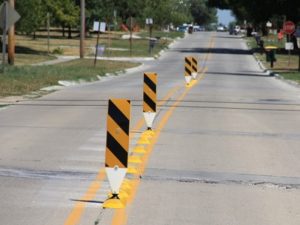Narrowing: Vertical Centerline Treatments
Vertical centerline treatments provide a sense of friction and can narrow lane width through the use of longitudinal channelizers.

Vertical centerline treatments provide a sense of friction and can narrow lane width through the use of longitudinal channelizers. Depending on where channelizers are used, they may be between 18 and 36 inches tall, spaced roughly 3 feet apart, and be yellow or orange in color.
Channelizers have been used in workzones, high-occupancy vehicle (HOV) lanes, and on ramp exits. Special considerations must be taken when large trucks or farm equipment are present, because channelizers may restrict movements. Other vertical centerline treatments include use of raised pavement markings or raised curbing.
Advantages
- Separates traffic
- Impact resistant
Disadvantages
- Requires maintenance with repeated impacts
- Wide vehicles and farm machinery have difficulty maneuvering (common in Iowa), so special consideration is needed
Effectiveness
The ability of longitudinal channelizers to reduce speeds is not well documented. The majority of research regarding these devices pertains to their use at highway-railroad grade crossings.
The North Carolina DOT (NCDOT), for instance, placed the delineators along the centerline of the roadway extending about 100 feet from the railroad gates to dissuade drivers from going around the gates. Afterward, they found the delineators reduced violations by 77 percent (ATSSA 2006). Longitudinal channelizers were used to create a center median as part of a rural traffic calming project (Hallmark et al. 2007) with reductions of up to 3.0 miles per hour (mph) in mean speed and 3 mph in 85th percentile speed.
No crash modification factors (CMFs) were found relating to longitudinal channelizers.
Appropriateness
Vertical centerline treatments are not appropriate for all situations but could be used to give drivers the perception of lane narrowing when entering a town.
Cost
Longitudinal channelizers, raised pavement markings, and temporary curbing are a low-cost option for narrowing lanes.
References
ATSSA. Low Cost Local Road Safety Solutions. American Traffic Safety Services Association, Fredericksburg, VA, 2006.
Hallmark, Shauna, Eric Peterson, Eric Fitzsimmons, Neal Hawkins, Jon Resler, and Tom Welch. Evaluation of Gateway and Low-Cost Traffic-Calming Treatments for Major Routes in Small Rural Communities. Center for Transportation Research and Education, Iowa State University, 2007.
